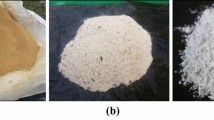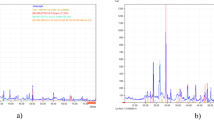Abstract
Crushed shales obtained from two locations (Ahoko, Bida basin and Ifon, Dahomey basin) in Nigeria were evaluated to determine their suitability as compacted landfill liners. The shale samples were subjected to X-ray diffraction, hydraulic conductivity, classification, compaction, consolidation and cation exchange capacity tests. The result of the XRD revealed kaolinite and illite as the major clay minerals while quartz was the dominant non-clay minerals. The average CEC of Ifon and Ahoko shales was 5.37 and 8.34 mEq/100 g, respectively. The liquid limit, plastic limit and plasticity index of crushed Ifon shales ranged from (33.9 to 37.4%), (25.2 to 27.2%) and (8.6 to 10.2%) while the Ahoko shales ranged from (44 to 46.4%), (26.3 to 27.4%) and (16.6 to 19.6%), respectively. In addition, the estimated activity of the clay fractions of the two shales ranged from 0.41 to 0.51, suggesting inactive clays. The compacted shales have low compressibility and when compacted at modified Proctor level of compaction. At molding water content between optimum moisture content (OMC) ±2%, the hydraulic conductivities of the compacted shale were in the order of 10−6–10−7 cm/s when compacted at modified Proctor level. At OMC, hydraulic conductivities of the compacted shales were in the order of 10−7 cm/s when exposed to different concentration of calcium chloride solutions. Overall, the crushed shale samples from Ahoko and Ifon generally fulfilled the basic geotechnical properties for compacted clay liners.







Similar content being viewed by others
References
Abichou T, Benson CH, Edil TB, Tawfiq K (2004) Hydraulic conductivity of foundry sands and their use as hydraulic barriers. In: Aydilek AH, Wartman J (eds) Recycled materials in geotechnics. Geotechnical Special Publication 127, ASCE, New York
Adeleye DR (1974) Sedimentology of the fluvial Bida Sandstone (Cretaceous), Nigeria. Sediment Geol 12:1–24. doi:10.1016/0037-0738(74)90013-X
Aluko OO, Sridhar MKC, Oluwande PA (2003) Characterization of leachates from a municipal solid waste landfill site in Ibadan, Nigeria. J Environ Heal Res 2:32–37
Ameratunga J, Sivakugan N, Das BM (2016) Correlations of soil and rock properties in geotechnical engineering. Developments in geotechnical engineering. Springer, New Delhi
Arasan S (2010) Effect of chemicals on geotechnical properties of clay liners: a review. Res J Appl Sci Eng Technol 2:765–775
Arasan S, Yetimoǧlu T (2008) Effect of inorganic salt solutions on the consistency limits of two clays. Turkish J Eng Environ Sci 32:107–115
ASTM D1557 (2012) Standard test methods for laboratory compaction characteristics of soil using modified effort (56,000 ft-lbf/ft3 (2,700 kN-m/m3)). ASTM International, West Conshohocken
ASTM D5856 (2007) Standard test methods for measurement of hydraulic conductivity of porous materials using a rigid-wall compaction-mold permeameter. ASTM International, West Conshohocken
ASTM D698 (2012) Standard test methods for laboratory compaction characteristics of soil using standard effort (12 400 ft-lbf/ft3 (600 kN-m/m3)). ASTM International, West Conshohocken
Bell FG (2000) Engineering properties of soils and rocks, 4th edn. Blackwell Science, London
Benson CH, Hardianto FS, Motan SE (1994) Representative specimen size for hydraulic conductivity assessment of compacted soil liners. In: Daniel DE, Trautwein SJ (eds) Hydraulic conductivity and waste contaminant transport in soil. ASTM STP 1142, American Society for Testing and Materials, Philadelpia
Blotz LR, Benson CH, Boutwell GP (1998) Estimating optimum water content and maximum dry unit weight for compacted clays. J Geotech Geoenviron Eng 124(9):907–912
British Standard 1377 (1990) Methods of test for soils for civil engineering purposes. British Standard Institution, London
Broderick GP, Daniel DE (1990) Stabilizing compacted clay against chemical attack. J Geotech Eng 116:1549–1567. doi:10.1061/(ASCE)0733-9410(1990)116:10(1549)
Budhu M (2015) Soil mechanics fundamentals. Wiley, London
Burgos P, Madejón E, Pérez-de-Mora A, Cabrera F (2008) Horizontal and vertical variability of soil properties in a trace element contaminated area. Int J Appl Earth Obs Geoinf 10:11–25. doi:10.1016/j.jag.2007.04.001
Chhabra R, Pleysier J, Cremers A (1975) The measurement of the cation exchange capacity and exchangeable cations in soils: a new method. In: Proceedings of the International Clay Conference, Wilmette, Illinois, pp 439–449
Daniel DE, Benson CH (1990) Water content-density criteria for compacted soil liners. J Geotech Eng 116:1811–1830. doi:10.1061/(ASCE)0733-9410(1990)116:12(1811)
Elueze AA (2000) Compositional appraisal and petrotectonic significance of the Imelu banded ferruginous rock in the Ilesha schist belt, southwestern Nigeria. J Min Geol 36(1):8–18
Francisca FM, Glatstein DA (2010) Long term hydraulic conductivity of compacted soils permeated with landfill leachate. Appl Clay Sci 49:187–193. doi:10.1016/j.clay.2010.05.003
Gordon M, Huebner P, Kmet P (1990) An evaluation of the performance of four clay lined landfills in Wisconsin. In: Proceedings of the seventh annual waste conference. University of Wisconsin-Madison, Wisconsin, pp 399–460
Guney Y, Koparal S, Aydilek AH (2008) Sepiolite as an alternative liner material in municipal solid waste landfills. J Geotech Geoenviron Eng 134(8):1166–1180
Hamdi N, Srasra E (2013) Hydraulic conductivity study of compacted clay soils used as landfill liners for an acidic waste. Waste Manag 33:60–66. doi:10.1016/j.wasman.2012.08.012
He J, Wang Y, Li Y, Ruan X (2015) Effects of leachate infiltration and desiccation cracks on hydraulic conductivity of compacted clay. Water Sci Eng 8:151–157. doi:10.1016/j.wse.2015.04.004
Kayabali K (1997) Engineering aspects of a novel landfill liner material: bentonite-amended natural zeolite. Eng Geol 46:105–114. doi:10.1016/S0013-7952(96)00102-0
Kayabalı K, Mollamahmutoğlu M (2000) The influence of hazardous liquid waste on the permeability of earthen liners. Environ Geol 39:201–210. doi:10.1007/s002540050001
Kjeldsen P, Barlaz MA, Rooker AP, Baun A, Ledin A, Christensen TH (2002) Present and long-term composition of MSW landfill leachate: a review. Crit Rev Environ Sci Technol 32:297–336
Koch D (2002) Bentonites as a basic material for technical base liners and site encapsulation cut-off walls. Appl Clay Sci 21:1–11
Kogbe CA (1976) The Cretaceous and Palcogene sediments of southern Nigeria. In: Kogbe CA (ed) Geology of Nigeria. Elizabcthun, Sydney, pp 273–292
Kulhawy FH, Mayne PW (1990) Manual on estimating soil properties for foundation design, Report EL-6800. Electric Power Research Institute, Palo Alto
Li J, Xue Q, Wang P, Liu L (2013) Influence of leachate pollution on mechanical properties of compacted clay: a case study on behaviors and mechanisms. Eng Geol 167:128–133. doi:10.1016/j.enggeo.2013.10.013
Liu HL, Zhu CP, Zhang XL (2008) Fundamental physical properties of soil polluted by acid and alkali in laboratory. Chin J Geotech Eng 30(8):1213–1217
Łuczak-Wilamowska B (2002) Neogene clays from Poland as mineral sealing barriers for landfills: experimental study. Appl Clay Sci 21:33–43. doi:10.1016/S0169-1317(01)00090-4
Malusis MA, Shackelford CD (2002) Theory for reactive solute transport through clay membrane barriers. J Contam Hydrol 59:291–316. doi:10.1016/S0169-7722(02)00041-4
Met İ, Akgün H (2015) Geotechnical evaluation of Ankara clay as a compacted clay liner. Environ Earth Sci 74:2991–3006. doi:10.1007/s12665-015-4330-x
Mitchell JK, Soga K (2005) Fundamentals of soil behavior, 3rd edn. Wiley, Hoboken
Mohamedzein YE-A, Al-Rawas AA, Al-Aghbari MY et al (2005) Assessment of crushed shales for use as compacted landfill liners. Eng Geol 80:271–281. doi:10.1016/j.enggeo.2005.06.001
Nelson JD, Chao KC, Overton DD, Nelson EJ (2015) Foundation engineering for expansive soils, 1st edn. Wiley, Hoboken
Obrike SE, Osadebe CC, Omoniyi SS (2009) Geotechnical analysis of two Nigerian soils for use as clay liners. Bull Eng Geol Environ 68:417–419. doi:10.1007/s10064-009-0189-y
Ojo OJ, Akande SO (2009) Sedimentology and depositional environments of the Maastrichtian Patti Formation, southeastern Bida basin, Nigeria. Cretac Res 30:1415–1425. doi:10.1016/j.cretres.2009.08.006
Ojoawo SO (2012) Characterization of dumpsite leachate: case study of Ogbomosoland, South-Western Nigeria. Open J Civ Eng 02:33–41. doi:10.4236/ojce.2012.21006
Oweis IS, Khera RP (1990) Geotechnology of waste management. Butterworth & Co. (Publishers) Ltd., University Press, Cambridge
Oztoprak S, Pisirici B (2011) Effects of micro structure changes on the macro behaviour of Istanbul (Turkey) clays exposed to landfill leachate. Eng Geol 121:110–122. doi:10.1016/j.enggeo.2011.05.005
Park J, Vipulanandan C, Kim J, Oh M (2006) Effects of surfactants and electrolyte solutions on the properties of soil. Environ Geol 49:977–989. doi:10.1007/s00254-005-0136-6
Qian X, Koerner RM, Gray DH (2002) Geotechnical aspects of landfill design and construction. Prentice-Hall Inc., New Jersey
Rahman F (2000) Hydraulic conductivity and chemical compatibility of some victorian soils used as liners for waste containment, Ph.D. Thesis, Victoria University of Technology Melbourne, Australia, p 365
Rowe RK (2010) Systems engineering the design and operation of municipal solid waste landfills to minimize contamination of ground water. In: Chen Y, Zhan L, Tang X (eds) Advances in environmental geotechnics. Springer, Berlin
Rowe RK, Quigley RM, Brachman RWI, Booker JR (2004) Barrier systems for waste disposal facilities, 2nd edn. Spon Press, London
Shariatmadari N, Salami M, Fard MK (2011) Effect of inorganic salt solutions on some geotechnical properties of soil–bentonite mixtures as barriers. Int J Civ Eng 9(2):103–110
Sharma HD, Reddy KR (2004) Geoenvironmental engineering: Site remediation, waste containment, and emerging waste management technologies. Wiley, New York
Taha MR, Kabir MH (2003) Sedimentary residual soils as a hydraulic barrier in waste containment systems. In: Second international conference on advances in soft soil engineering technology, Putrajaya, Malaysia, pp 895–904
Tijani MN, Bolaji OP (2007) Sorption and engineering characteristics of some clay/shale deposits from Nigeria as landfill liner. In: International meeting, clays in natural and engineered barriers for radioactive waste confinement, Lille, France, pp 376–378
Tijani MN, Adesina RB, Wagner J-F (2012) Geotechnical and geochemical assessments of shales in Anambra basin, SE-Nigeria as compacted clay liner in landfill system. Clays in natural and engineered barriers for radioactive waste confinement—5 International meeting Book of abstracts, p 923, France
Wesley LD (1988) Compression index: misleading parameter? J Geotech Eng 114:718–723. doi:10.1061/(ASCE)0733-9410(1988)114:6(718)
Whitlow R (2000) Basic soil mechanics, 4th edn. Prentice Hall, London
Xue Q, Zhang Q (2014) Effects of leachate concentration on the integrity of solidified clay liners. Waste Manag Res 32:198–206. doi:10.1177/0734242X14521679
Yılmaz G, Yetimoglu T, Arasan S (2008) Hydraulic conductivity of compacted clay liners permeated with inorganic salt solutions. Waste Manag Res 26:464–473. doi:10.1177/0734242X08091586
Acknowledgements
The authors thank Professor Edil T.B and the reviewers for the valuable comments and helpful suggestions during the paper review process.
Author information
Authors and Affiliations
Corresponding author
Rights and permissions
About this article
Cite this article
Afolagboye, L.O., Talabi, A.O., Ajisafe, Y.C. et al. Geotechnical Assessment of Crushed Shales from Selected Locations in Nigeria as Materials for Landfill Liners. Geotech Geol Eng 35, 1847–1858 (2017). https://doi.org/10.1007/s10706-017-0213-0
Received:
Accepted:
Published:
Issue Date:
DOI: https://doi.org/10.1007/s10706-017-0213-0




